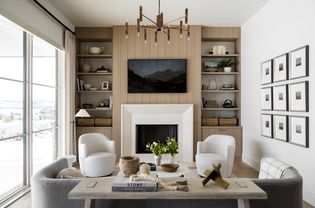When it comes to your home, the heart wants what the heart wants. So you find a trusted designer and lay out your vision. And get a blank stare. The customer might always be right, but that doesn’t mean that a real pro won’t try to nudge the needle toward a more palatable - and timeless -outcome for their client.
After all, creating substantive changes in your home is a big investment, and not only do you want to love the look now, but you also want future you to enjoy the transformation without a cringe and a “What was I thinking?” To that end, we asked a few top designers what trends or styles were a big “no go” in their opinion.
Maximalism
For celebrity designer Bobby Berk, the design guru on Netflix’s “Queer Eye” and creator of Bobby Berk Design, too much is, well, too much. “I'm really a minimalist at heart, and like spaces that feel quite paired down and clean,” he says. “While I do think the "maximalist" look with a lot of colors, prints and patterns works in a lot of spaces, I prefer something a bit more organized and subdued. I would constantly have the urge to pair things down (and put things away!) if I lived in maximal space.”
Shabby Chic
No doubt shabby chic is having its day. Think faux-distressed furniture and accessories to true vintage pieces that long to create a certain type of elegant inelegance that evokes times gone by. A style that looks lived in, even if it just came off a modern showroom floor. But such an aesthetic and ideal is not for everyone.
“Shabby Chic is a design style on the top of the “not for me” list,” says top designer Amhad Freeman of Amhad Freeman Interiors. “My approach to design is pared-back, sleek and carefully edited so anything crowded and maximalist feels like a personal contradiction! In my work, I strive to create comfortable spaces for people to spend their lives and pursue their dreams. The design of your home impacts you and I believe that design should be calm and serene so you can return from a busy day and relax.”
So, does that mean no surfaces full of your collection of cute knick-knacks and walls full of kitschy, home-spun sayings?
“I stay away from clutter or anything that feels fast, including loud colors that can be too bright or even jarring. Too much stimulation can create a sense of anxiety, which goes against my natural inclination to curate balanced, harmonious spaces for clients that provide respite,” Freeman says. “My design style is innately intentional: Every decision, every object has a reason behind it and careful editing delights my design heart (and mind!).”
Going Totally Traditional
If what is old is not what should be new again, what does that mean for going traditional with your home’s decor? Not always the best route for an overall theme, says Berk.
“I also think that traditional interiors are a lot more exciting when you bring in a mix of other styles and references that have a totally unique feel.” he says. “Sticking to totally traditional for every piece works well for a historic home, but for most spaces, contrasting with more modern elements adds a lot of interest (and some unexpected moments).”
That means maybe dialing back the Victorian overhaul or going with one or two pieces of Chesterfield furniture.
Things to Watch for No Matter the Trend
In every trend lives common elements that can make or break your home’s look, both in form and function. Even if the overall theme makes your heart sing, if it doesn’t work for how you and your family live, or knocks the overall feel of your space out of balance, you won’t be happy with the outcome.
The team at Kate Marker Interiors came up with a list of design choices they don’t recommend for your home, regardless of what trend you are chasing:
Double-Tiered Counters
Stay away from kitchen counters that are divided with one half a normal height for a workspace and the second half elevated to bar stool height. It’s all about balance, and this not only looks off, but it cuts back on workable surface area.
Multiple Uses of Same Lighting Theme
Taking a lighting look too far. For instance, using a lantern-type in the kitchen, over an island, and in the dining room. Again, less is more.
Single Furniture Style and Same Vendor
Furnishing your entire home with not only one style, but with all the pieces from the same vendor. This will quickly date your design.
Lack of Interest on Walls
Make sure whatever trend you tackle, you don’t forget your walls. Long expanses of only drywall, even if painted, interrupts the flow of a design. Those long walls need art, wallpaper, sconces—something to add interest and keep your space on theme.
If your mind's made up on following a hot new trend or one that persists despite many others' reservations, you can probably find a designer who will accommodate your wishes. But before you embark on that redesign, take heed of what these pros have on their “don’t do it” list. You just might end up going down a path that leads to even greater home joy.

:max_bytes(150000):strip_icc()/GettyImages-523328574-664e77e2191e41e69950924c7cb16a52.jpg)
